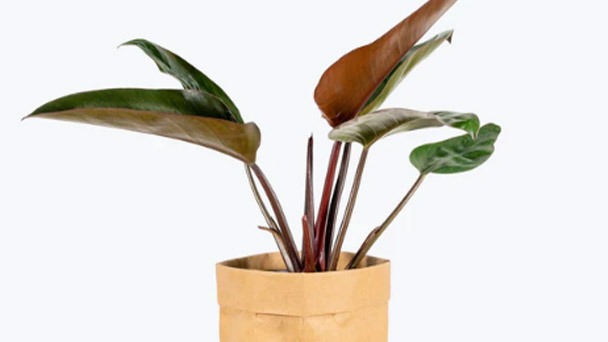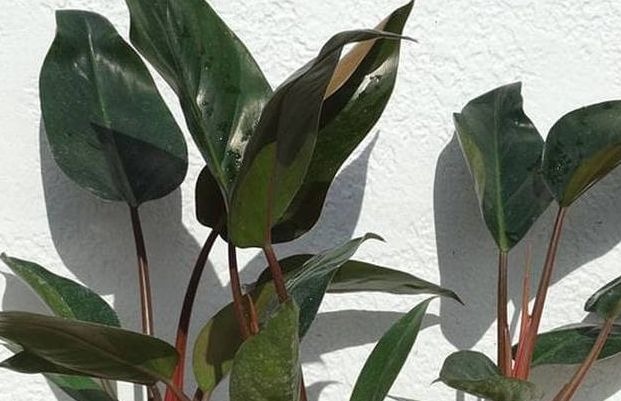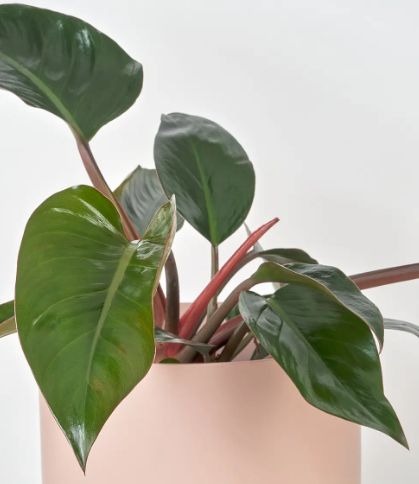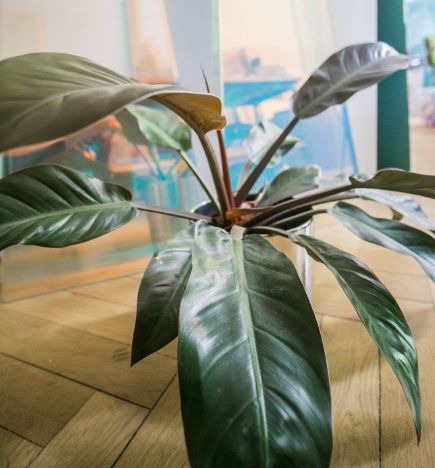Philodendron Rojo Congo Care & Propagation
Written by Ivy
Jan 07 2023

As long as you keep the philodendron Congo Rojo warm, maintaining it is very simple. Due to its extreme sensitivity to cold, the plant will suffer severe harm below 40 F. (4 C.). To give the Rojo Congo Philodendron the best care possible, place it in a location with bright but indirect sunlight, consistently moisten the soil, maintain average temperatures, use organic fertilizers, and prune off dead leaves as needed.
A hybrid philodendron variety called philodendron rojo congo was produced by mating philodendron tatei and philodendron imperial red. The rojo congo's color resembles an imperial red more than a tatei, and its leaf shape is more tatei-like.
Philodendron Rojo Congo Overview
| Scientific Name | Philodendron tatei ‘Congo Rojo' |
| Common Name | Philodendron Rojo Congo, Rojo Congo, Congo Red |
| Light | Bright indirect sunlight |
| Watering | Water if the top 2 inches of soil are dry |
| Temperature | 65 to 80ºF (18 to 27ºC) |
| Hardiness Zone | 9b to 12 |
| Humidity | 50% |
| Soil Type | Rich, quick-draining, loamy |
| Soil pH | 5.6 to 6 (acidic) |
| Fertilizing | A balanced feed once a month in spring and summer |
| Repotting | Every year |
| Pruning | Spring and summer |
| Propagation | Division |
| Toxicity | Toxic to humans and pets |
| Mature Size | 24 to 36 inches as a houseplant |
| Bloom Time | Rarely blooms indoors |
Philodendron Rojo Congo Care

These understory plants thrive in a warm, humid environment in dappled shade in the tropical rainforests that give rise to the philodendron family.
You must comprehend these fundamental needs in order to properly care for your Philodendron Rojo Congo plant.
Bright, indirect light, warm, and humid weather, as well as regular light watering, are necessary for providing proper care for Rojo Congo plants.
Light
Despite never having actually grown in a tropical rainforest, Philodendron Rojo Congo has inherited the wild ancestors' need for Rojo Congo light.
The canopy of trees that the sun's rays travel through as they reach the forest floor filters the sun's glare.
Philodendron Rojo Congo prefers indirect light that is bright and between 10,000 and 20,000 lux in your home.
Rarely will your Philodendron Rojo Congo require plant lights to provide enough lux.
While a south or west-facing room should have a spot out of the direct sunlight, which can cause serious harm to the leaves, a north or east window will work just fine.
Watering
It's crucial to maintain a regular watering schedule. The soil should be kept moist but not drenched in the summer. You can check this by sticking your finger into the top 5 cm of the potting mix and feeling the soil's moisture content before watering. Give it more time to dry if it feels wet. Overwatering can cause root rot or fungus problems. Use only enough water to see some draining from the bottom of the pot when watering once a week. The frequency of watering should be decreased during the winter months when the plant isn't actively growing.
Temperature
The Philodendron Rojo Congo prefers temperatures between 65 and 80 °F (18 and 27 °C).
While 65°F (18°C) is sufficient for Rojo Congo, higher temperatures will promote quicker growth and larger leaves. In the rainforest, philodendrons are accustomed to tropical temperatures.
However, the Philodendron Rojo Congo's tolerance for low temperatures plummets precipitously below 55°F (13°C), and prolonged exposure could result in death.
Keep it away from drafts and chilly windows. It can even be dangerous to stand too close to an air vent.
Due to its complete incapability to withstand frost, Philodendron Rojo Congo will perish if exposed to subfreezing conditions.
Humidity
Due to the naturally steamy conditions of the rainforests, Philodendron Rojo Congo humidity needs are moderately high.
Although 60% or more humidity is ideal for Rojo Congo, you can usually get away with 40%.
It's time to figure out a way to raise the humidity for your tropical plant, though, if you notice brown tips or margins on the leaves of your Philodendron Rojo Congo.
Misting only gives a brief boost, and wet leaves can spread disease, so it isn't very effective.
Setting a pebble tray filled with water under your Philodendron Rojo Congo or investing in a humidifier will do much better to ensure the health of all your tropical plants.
Soil
When selecting soil for Philodendron Rojo Congo, two factors must be taken into account: it must drain well and maintain an even moisture level. Soggy soil will not be acceptable to these plants.
For Rojo Congo, an acidic pH range of 5.6 to 6 is ideal.
Pure peat moss, which will both hold onto moisture and prevent the roots from drowning, is the simplest soil for Rojo Congo.
You can avoid fertilizing your Philodendron Rojo Congo by adding a small amount of well-rotted compost.
Additionally, you can purchase a commercial aroid soil blend that doesn't require any alterations.
Fertilizer
If you haven't added compost to your Philodendron Rojo Congo soil mix, you will need to use a
fertilizer called Philodendron Rojo Congo.
While a fertilizer with a balanced fertilizer ratio can be used for Rojo Congo, a nitrogen-rich formula like 3-1-3 or 3-1-2 will promote leaf growth.
The simplest to apply is a liquid fertilizer. Use it once every month, immediately after watering, at half the recommended strength.
For even absorption, pour it evenly over the soil's surface.
When the plant is actively growing, which is in the spring and summer, repeat this process every month. When the plant is dormant, which is in the fall and winter, stop.
Potting & Repotting
Up until the plant reaches its full size, which will take about 5 years, Philodendron Rojo Congo repotting should be carried out annually.
To know when it's time, look for roots emerging from the drainage holes.
Rojo Congo will need to be repotted after that to get new potting soil every couple of years.
To avoid stunting the growth of your Philodendron Rojo Congo, only slightly increase the pot size when switching to a larger one—no more than an inch or two.
Use a large ceramic or clay pot with drainage holes to balance the plant's weight.
Pruning
Almost never will you need to prune a Philodendron rojo congo.
This hybrid was created to naturally form a rosette and will stay compact and orderly without any shaping.
You will typically only cut Rojo Congo to remove any dead leaves. Removing the outer leaves will keep your plant looking its best because they will naturally fall off.
You might occasionally have minor flaws like brown edges on the edges of your Philodendron Rojo Congo leaves. Use tiny, sharp scissors to carefully trim off the damaged area rather than chopping off the entire leaf.
Propagation
The patent on Philodendron Rojo Congo expired in January 2022, which means that propagating this plant for any reason is now completely legal.
Rojo Congo grows best when offsets are divided because the plant has already done the majority of the work for you.
Repotting the plant after removing the root ball from the pot makes this task simpler.
Keep an eye out for little plantlets edging the mother plant. Make sure you have a baby with roots and a stem as you carefully pull them away.
Place them in their own pots before planting.
Check out our comprehensive guide to caring for Philodendron selloum plants as well.
Common Problems of Philodendron Rojo Congo
Most Philodendron Rojo Congo issues are avoidable or simple to fix.
Giving Rojo Congo as close to its ideal growing conditions as you can will help you avoid problems.
If the leaves of your Philodendron Rojo Congo exhibit any symptoms of distress or ill health, you should identify the issue right away and then implement the appropriate remedy.
Pests
The majority of the usual suspects are included in Philodendron Rojo Congo pests.
By wiping down the large leaves of your Rojo Congo once a month with an insecticidal soap or neem oil solution, you can keep it free of pests. Your Philodendron Rojo Congo will remain pest-free and clean as a result of this.
Small flying insects with soft bodies known as aphids are known for sucking sap from leaves and stems.
Spider mites go unnoticed most of the time, but their webs and tiny yellow bumps on the leaves are clues to their presence.
By thoroughly showering your Philodendron Rojo Congo, you can get rid of both of these pests.
Mealybugs, which resemble masses of white fluff, congregate beneath the leaves. To remove them, blot a cotton ball with alcohol.
Diseases
Keep the soil just moist and the leaves of your Philodendron Rojo Congo dry to prevent any diseases from spreading.
In the event that your Rojo Congo does contract a bacterial or fungal infection, you must act quickly to save the plant and prevent the disease from infecting other plants in your indoor garden.
With a foul smell, Xanthomonas causes dark spots that are circled in yellow.
As a result of the Erwinia blight, leaves develop mushy, wet patches that quickly spread to cover the entire leaf.
Root rot makes once-healthy roots turn black and stench, while also turning leaves yellow and softening stems.
Remove and throw away any infected body parts for any of these diseases. Your Philodendron Rojo Congo needs to be repotted in a new container with new soil.

Growing Problems
Simply improving your Philodendron Rojo Congo's growing conditions will solve any additional growing issues. Once that's finished, your sick plant should make a full recovery.
Your Philodendron Rojo Congo isn't getting enough light if its leaves have faded or if it appears leggy. It should be moved to a more sunny location and pruned to promote new growth.
Too-cold temperatures can result in dark patches on leaves or leaf dropout. It should not be near chilly windows or in drafts.
Overexposure to the sun has burned the leaves that are brown. Remove the damaged foliage and place it in a more shaded area.
Toxicity of Philodendron Rojo Congo
Both humans and animals can be fatally poisoned by rojo congo, but this is rare.
Crystals of calcium oxalate, which can pierce delicate tissues like skin and membranes, are present in Philodendron rojo congo in all of its parts.
Use caution when growing philodendron Rojo Congo in a home with young children and pets due to its toxicity.
For Humans
Despite the fact that Philodendron Rojo Congo is toxic to people, if you take sensible precautions, you shouldn't need to worry too much.
When working with your Philodendron Rojo Congo, you should always wear gloves because even the sap can result in an itchy rash. If any of it touches your skin, rinse it off.
Although children are more likely to consume some of the foliage, they are unlikely to consume more than a small amount because they will feel pain right away.
Get them to rinse and spit, and give them something to relieve the discomfort, like a popsicle.
However, take them right away to the emergency room if their tongue or throat are swollen.
For Pets
If pets consume some Philodendron Rojo Congo foliage, they could suffer serious organ damage.
The effects of consuming calcium oxalate are equally harmful to cats, dogs, and rabbits.
Immediately take your pet to the vet if it begins to cough or drool excessively, or if it experiences vomiting or diarrhea.
Consider putting your Philodendron Rojo Congo somewhere that kids and pets can't get to it before it gets to this point.
Even at full size, it will only be 3 feet at most, so you can put it on a table or ledge out of their reach.
Philodendron Rojo Congo Appearance
Large, vividly colored leaves are what give the Philodendron Rojo Congo its stunning appearance.
They come in a variety of hues, from a bright orange-red to a deep green with burgundy overtones.
Without the need for pruning, the Philodendron Rojo Congo plant develops a graceful shape on its own.
Although plants grown outside are capable of flowering, the blooms are unremarkable.
Foliage
The Philodendron Rojo Congo has stunning foliage that is dramatically colored, making it the ideal plant for a modern environment.
Approximately 18 inches long and 12 inches wide, and shaped like an elongated oval, are the dimensions of a mature Philodendron Rojo Congo leaf.
The plant's center produces new, vibrant red leaves that unfold. As they get older, they develop bright red petioles and a dark green color with burgundy overtones.
You will simultaneously have both mature and young leaves, which will contrast in color.
The leaves are glossy and have a thick, leathery texture.
To keep leaves clean, wipe them down once per month.
Flowering
Before you have a chance to see a Rojo Congo flower, it may take a few years, but it is unlikely to occur indoors and isn't really worth holding your breath for.
The small, insignificant flowers on Philodendron Rojo Congo are typically tucked beneath the big leaves, so the flowering is hardly noticeable. They have no scent.
Since the energy that would go into blooming is better directed toward leaf growth, many growers simply cut off the flower stems when they emerge.
Realistically, there is very little chance that a plant grown indoors will bloom. Instead of attempting the impossible, take in the magnificent leaves.
Size and Growth
The mature size of Philodendron Rojo Congo is ideal for a small house or apartment.
A Philodendron Rojo Congo grown outdoors in a tropical region has the potential to grow to 10 feet tall and spread out over 5 years.
It may reach a height of 3 feet and a similar spread when grown indoors in a pot. It grows at a moderate rate.
Naturally, the Philodendron Rojo Congo forms a compact rosette shape with stems emerging from a thin central stem.
The plant's center produces new leaves, while the older leaves drop off starting at the bottom outside edge.
Is Red Congo a Rubber Plant?
No, philodendron red congo is not a rubber plant. "Rubber plant" is the common name for a variety of ficus plant called the "ficus elastica." The most common type of rubber plant is the "ficus elastica burgundy," or "burgundy rubber plant."
These plants do resemble one another when viewed from a distance. The new growth tips on a rubber plant can be bright red, which may resemble the stems on a rojo congo. The leaves of a rubber plant can also have a similar color. However, the genus of the rubber plant, ficus, is completely unrelated. Philodendron is the scientific name for a rojo congo.

Suggested Uses for Philodendron Rojo Congo
A Philodendron Rojo Congo plant can be used indoors in a variety of settings, wherever you need a striking splash of vibrant color.
You can place it on a ledge or table in a roomy bathroom, where it will benefit from the increased humidity whenever you take a shower.
Use it as an accent plant in a modern living room so that it will pop against the white walls.
Additionally, during the sweltering summer, it makes the ideal plant for a shaded area of a balcony or patio.
Philodendron Rojo Congo can, of course, be grown as a landscape plant in tropical climates, where it will quickly develop into a sizable, evergreen bush.
Conclusion
It may appear tropical and labor-intensive, but the philodendron rojo congo isn't at all like that. It has adapted well to life indoors and grows quite well as a houseplant. They are true scroll-stoppers that are also very simple to grow and maintain. Enjoy growing your red philodendron, and please let me know if you have any questions down below.
FAQs
What is Philodendron Rojo Congo?
A Florida plant breeder recently developed the hybrid philodendron cultivar known as Philodendron Rojo Congo, which is distinguished by its strikingly colored foliage. It is a well-liked houseplant.
How to Identify Philodendron Rojo Congo?
Large, ovate, initially orangey-red leaves on the Philodendron Rojo Congo mature to a dark green color. It forms a dense clump as it grows and has dark red petioles.
How to Care for Philodendron Rojo Congo?
Growing conditions for Philodendron Rojo Congo should include loose, porous soil that is kept only moderately moist and out of direct sunlight.
How to Grow Philodendron Rojo Congo Indoors?
As a potted plant, Philodendron Rojo Congo can be grown in a warm, humid environment with bright, indirect light. Regularly, lightly water the plants.
How to Grow Philodendron Rojo Congo Outdoors?
Growing zones 9b to 12 allow for year-round outdoor cultivation of Philodendron Rojo Congo, while temperate zones allow for summertime outdoor growth.
How Fast Does Philodendron Rojo Congo Grow?
Philodendron Rojo Congo grows moderately quickly, taking about 5 years to reach its full size of 3 feet when grown indoors and 10 feet when grown outdoors.
How Tall Does Philodendron Rojo Congo Grow?
If grown outdoors in tropical climates, Philodendron Rojo Congo can reach heights of 10 feet and a spread of about 2 to 3 feet.
How to Make Philodendron Rojo Congo Grow Faster?
When Philodendron Rojo Congo is grown in extremely hot and muggy conditions with regular watering and bright but indirect light, it will grow the fastest.
How to Stake Philodendron Rojo Congo?
Without staking, Philodendron Rojo Congo naturally takes on an upright form. To prevent the pot from tilting toward the light, you can turn it a quarter turn once a week.
How to Pot Philodendron Rojo Congo?
The soil for potting Philodendron Rojo Congo should be loose, well-draining, and retain a moderate amount of moisture. Make sure the pot you use has good drainage holes.
How to Revive Philodendron Rojo Congo?
Try submerging the Philodendron Rojo Congo pot in a pail of lukewarm water, allowing the soil to become saturated, and then draining the extra water if the soil is dried out.
Why is My Philodendron Rojo Congo Dying?
It's possible that your Philodendron Rojo Congo has a bacterial or fungal infection. Be cautious when watering it after you have replaced all the damaged parts and removed all the affected parts.
Why is My Philodendron Rojo Congo Drooping?
Due to its soil being either too wet or too dry, your Philodendron Rojo Congo may be drooping. Either give it a good soak or repot it in new, loose soil.
How Cold Can Philodendron Rojo Congo Tolerate?
For Philodendron Rojo Congo to flourish, temperatures must be warm. Below 55°F (13°C), it won't thrive and is likely to suffer leaf damage. Temperatures below freezing will kill it.
How to Get Rid of Pests on Philodendron Rojo Congo?
Pests on Philodendron Rojo Congo can be eliminated by rubbing a solution of neem oil or insecticidal soap on the plant's leaves once a month.
Is Philodendron Rojo Congo Toxic to Cats?
Yes, cats are poisoned by Philodendron rojo congo. After eating some foliage, take your cat to the vet right away if it begins to drool, vomit, or wheeze.
Is Philodendron Rojo Congo Toxic to Dogs?
Yes, dogs are poisoned by Philodendron rojo congo. Take your dog to the vet if it is sneezing, drooling excessively, or experiencing vomiting or diarrhea.
Is Philodendron Rojo Congo Toxic to Children?
It is true that children should not use Philodendron Rojo Congo. Take your child right away to the emergency room if they have a swollen tongue or breathing issues.
Is Philodendron Rojo Congo Toxic to Humans?
Yes, Philodendron rojo congo is poisonous to people. If the sap gets on your skin, make sure to thoroughly rinse it off because it can result in an uncomfortable rash.
Does Philodendron Rojo Congo Have a Scent?
No, the Philodendron Rojo Congo lacks a scent. It is safe to use around people who have scent allergies because the rare flowers have no scent and the foliage has no detectable scent.
Latest Updated
- Benefits of Bugleweed - 7 Science-backed Health Benefits
- Bugleweed Dangers & Side Effects - Is It Poisonous?
- How to Plant Evergreen Trees - What You Should Know
- When to Plant Evergreens - Grow Guide for Evergreen Trees
- 12 Wonderful Evergreen Shrubs for Your Garden
- 12 Popular Evergreen Plants with Pictures for Beginners
- When And How To Prune A Lilac Bush Like a Pro
- How to Grow & Care for Lilac Vine (Hardenbergia Violacea)
- Japanese Lilac Tree (Syringa Reticulata) Care & Propagation Guide
- Shumard Oak Pros and Cons - What to Know
Popular Articles
- Winter maintenance of Antirrhinum Majus
- How to Grow Terminalia Mantaly Tree
- How to Grow and Care for Crossostephium Chinense
- How to grow Antirrhinum Majus in spring
- Peristeria Elata (Dove Orchid) Profile: Info & Care Guide
- Underwatered Snake Plant (Sansevieria Trifasciata) - Signs And How To Fix
- How to Care for Brazilian Jasmine Plant (Mandevilla Sanderi)
- How to Grow & Care for Graptopetalum Purple Delight in Summer
- Rosa Chinensis (China Rose): Plant Growing & Care Tips
- How to Care for Baby Sun Rose (Aptenia Cordifolia)